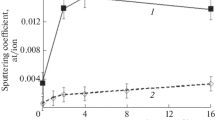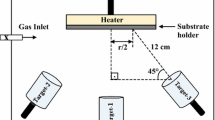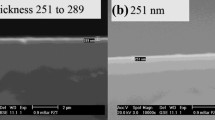Abstract
Metallic mirrors are now essential components of the (International Thermonuclear Experiment Reactor) ITER plasma diagnostics system. The optical properties of the first mirror (FM) in the hostile ITER environment have adverse effects due to erosion and deposition owing to high energy charge exchange of neutral (CXN) particles, UV, X-ray, and gamma radiation. Molybdenum (Mo) and rhodium (Rh) are attractive metals for the FM(s) as they can withstand the harsh conditions of the plasma environment and have better reflectivity. However, the high cost of Rh limits its use as a single material in the FM; as a result, it is deposited as a thin film over a metallic substrate. Moreover, due to the different thermal expansion of the coated materials on FM leads to weak adhesion of the thin layers thereby reducing the life of the coated mirror; this eventually leads to the deterioration of the optical properties of the diagnostic mirror. Furthermore, this phenomenon is becoming a problem concerning the stainability and reflectivity of the diagnostic mirror. This study aims to show the performance of niobium (Nb) as an interlayer between Mo and an Rh thin films deposited via DC magnetron sputtering at the deposition power of 40 W. The Mo mirrors were exposed to the high temperature and were left to cool naturally to room temperature. Rougher surfaces, larger grain sizes, and excellent adhesion were observed. The overall reflectance of the mirrors exposed to high temperature was reduced by 10–15%.
Similar content being viewed by others
References
L. Marot et al., Nucl. Fusion 56, 6 (2016).
L. Marot et al., J. Coating Sci and Tech. 2, 72 (2016).
L. Moser et al., Phys. Scripta T167, 14069 (2016).
A. Litnovsky, V. S. Voitsenya, A. Costley and A. J. H. Donne, Nucl. Fusion 47, 833 (2007).
B. Eren et al., J. Nuclear Material 438, S852 (2013).
Y. Krasikov et al., Fusion Eng. Design 124, 548 (2017).
B. Eren et al., Fusion Eng. Design 86, 2593 (2011).
L. Marot et al., Rev. Sci. Instrum. 78, 10 (2007).
A. Litnovsky et al., Fusion Eng. Design 123, 674 (2017).
J. C. Pivin, J. Mater. Sci. 18, 1267 (1983).
Thermal expansion coefficients of the elements available from https://en.wikipedia.org/wiki/Thermal_expansion_coefficients_of_the_elements (data_page).
H. Adachi, T. Hata and K. Wasa, Basic Process of Sputtering Deposition, Handbook of Sputter Deposition Technology, Second ed. (William Andrew, Elsevier, 2012), p. 295.
D-J. Kwak, B-W. Park, Y-M. Sung and M-W. Park, Japan Soc. Plasma Sci. Nucl. Fusion Res. 8, 1427 (2009).
B-C. Luo et al., J. Korean Phys. Soc. 68, 557 (2016).
J. A. Thornton and J. Y. Thompson, Annu. Rev. Mater. Sci. 7, 239 (1977).
Y. Shin et al., J. Korean Phys. Soc. 63, 1199 (2013).
X. Liu et al., J. Korean Phys. Soc. 71, 968 (2017).
Z. Suo, Motions of Microscopic Surfaces in Materials: Advances in Applied Mechanics (Academic Press, Elsevier, 1997), Vol. 33, p. 193.
I. J. Kang, M. G. Ko, J. K. Yang and H. J. Lee, J. Korean Phys. Soc. 63, 199 (2013).
J. E. Nestell and R. W. Christy, J. Vac. Sci. Technology 15, 366 (2002).
M. Nayak, G. S. Lodha and R. V. Nandedkar, Bull. Mater. Sci. 29, 693 (2006).
L. Marot et al., Thin Solid Films 516, 7604 (2008).
Acknowledgments
This research was supported by the 2019 Scientific Promotion Program funded by Jeju National University.
Author information
Authors and Affiliations
Corresponding author
Rights and permissions
About this article
Cite this article
Rai, S., Shaislamov, U., Yang, J.K. et al. Deposition and Characterization of a Rhodium Thin Films with a Niobium Interlayer on a Molybdenum Mirror for ITER First-Mirror Application. J. Korean Phys. Soc. 75, 644–651 (2019). https://doi.org/10.3938/jkps.75.644
Received:
Revised:
Accepted:
Published:
Issue Date:
DOI: https://doi.org/10.3938/jkps.75.644




